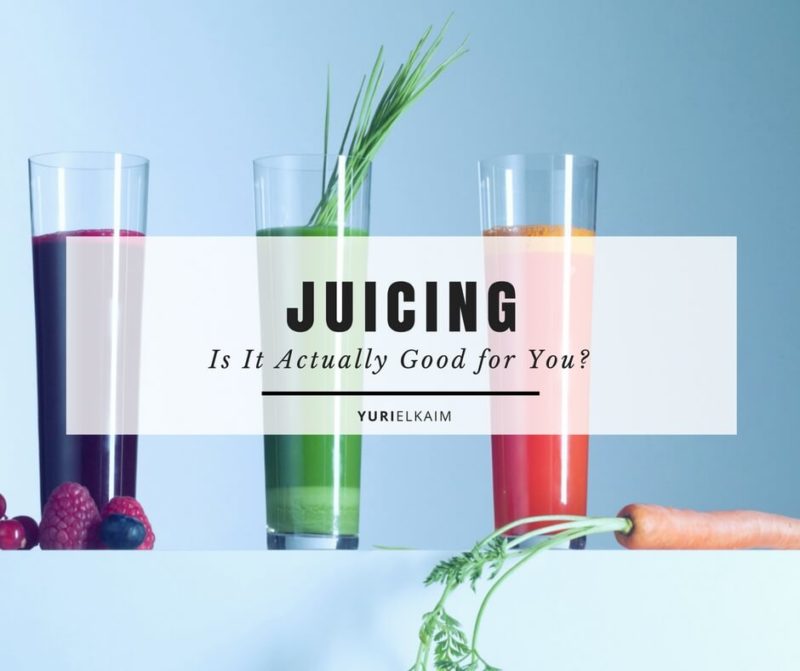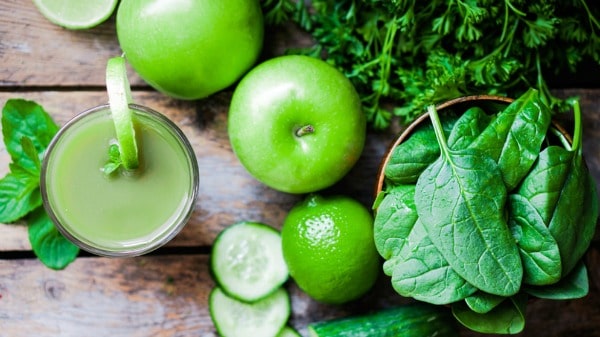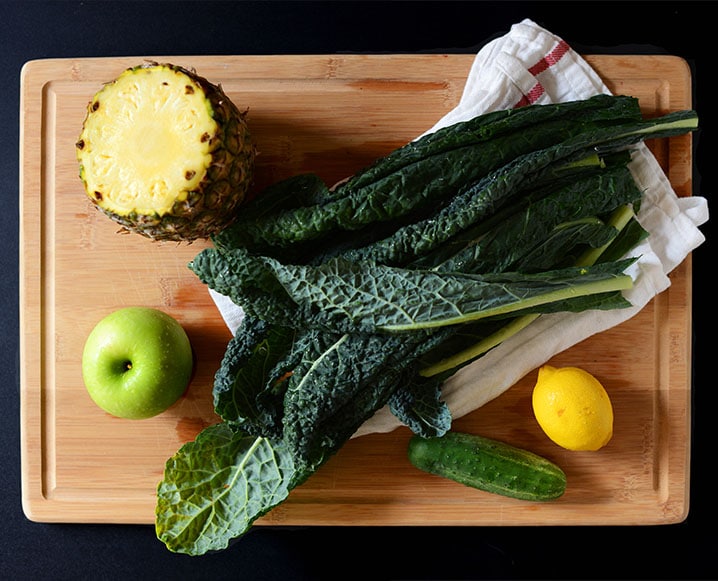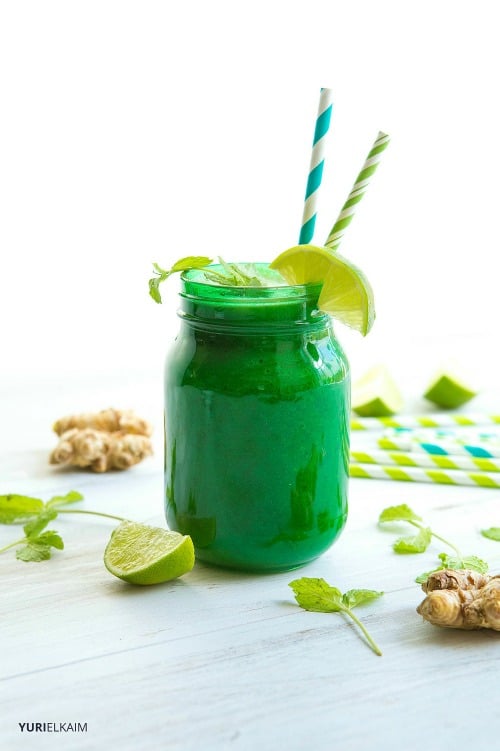In this article
How many servings of vegetables do you eat in a day?
If we’re being honest, many of us don’t get even close to the recommended five to nine servings of vegetables every day.
Seriously: between work and family responsibilities, who has time to keep track of how many veggies they’re eating in a day? Much less shop, prepare, cook, and eat them?
This is where juicing comes in.
During the past few years, juicing has exploded in popularity. Everyone from celebs to health gurus seems to have jumped on the juicing bandwagon, attributing everything from losing weight to boosting their energy (and general health) to juicing.
The idea of juicing is pretty appealing. You get all the vitamins and minerals that vegetables have to offer, but in a quick, easy, and concentrated amount. There’s no more meticulous counting or tracking (or cooking) just to make sure you’re meeting your needs.
That’s why juicing is one of the topics that I seem to get asked about a lot.
People are wondering if it’s really is as good as it sounds and are curious about the pros and cons of juicing. They wonder if you actually need to fill your plate with fruits and vegetables that you eat, or if drinking them can be just as effective.
Pros and Cons of Juicing
But when it comes to whether or not you should start juicing on a regular basis, the answer isn’t black and white. Here are a few things to consider next time you break out the juicer.
Top 3 Juicing Benefits
1. It can increase your fruit and vegetable intake.
If you’re the kind of person who can’t stand the sight of broccoli and the thought of wolfing down a big salad sounds nauseating, juicing might be a good solution to get more fruits and vegetables into your diet.
It’s also a good way to make sure you’re still getting enough fruits and veggies if you’re constantly crunched on time and struggling to even sit down for a full meal.
You can juice just about anything, so making juices to boost your intake of fruits and veggies you aren’t getting enough of is a definite positive to juicing. You should try to pick a variety of colors to get the widest array of vitamins and minerals in your diet.
2. It’s highly concentrated.
One serious benefit of juicing is that it provides loads of vitamins and minerals in a super concentrated form.
Instead of having to choke down an entire bunch of kale to get its vitamin K, potassium, and vitamin C, you can get the same nutrients in the form of a light and refreshing juice.
This is a big bonus for picky eaters who might not want to be gnawing on fruits and veggies all day but also want to avoid being deficient in important micronutrients.
3. It promotes absorption.
Starting your morning with a serving of green juice is basically like pumping your body with an IV full of nutrients. It’s incredibly concentrated, easily absorbed, and delivers a quick burst of nutrition almost instantly.
The effect of juicing on absorption is a definite pro.
The truth is that most of us have digestive difficulties, especially when it comes to foods that are harder to break down, like vegetables. This can make it especially hard to get the nutrients we need from them, as our body has difficulty with effectively digesting and absorbing nutrients.
This can lead to a whole host of health problems, all stemming from deficiencies of nutrients that our body depends on to survive.
This is where juicing really shines; it breaks down fruits and vegetables into a form that is super easy for our bodies to digest, meaning we’re able to get the maximum amount of nutrients possible in a highly digestible form.
Top 3 Cons of Juicing
1. You’re losing out on fiber.
One big thing to consider when you start juicing is the fiber factor.
See, fruits and vegetables are filled with fiber, which is really great because it goes through our digestive tract slowly and keeps us feeling fuller for longer.
Fiber is also linked to other important health benefits, like lowering the risk of chronic disease, controlling our weight, and slowing the release of glucose to prevent sudden spikes and drops in our blood sugar levels.
The biggest problem with juicing is that you’re basically throwing away all of that fiber, so you’re not getting any of the health benefits that come with it.
This is a serious drawback, since we need between 25 to 38 grams of fiber per day, and including a few servings of fruits and veggies is one of the easiest ways to reach that goal and keep us on track to good health.
2. It’s highly concentrated.
This one is both a pro and a con when it comes to juicing. As mentioned before, the fact that juicing gives you a highly concentrated dose of vitamins and minerals can be a really good thing.
But being so concentrated also comes with some drawbacks – especially when it comes to fruit.
Don’t get me wrong: fruit is awesome. It’s packed with vitamins, minerals, and fiber, all of which make it an essential part of any healthy and balanced diet.
The problem is that, along with all the good stuff, fruit also contains a decent amount of sugar. And with juicing, not only are you squeezing tons of vitamins and minerals into a single serving of juice, but you’re also exponentially increasing the sugar content.
In fact, when it comes to sugar, apple juice is actually worse than Coke.
Think about it like this: eating one banana might be healthy, but imagine eating four, five, or even six bananas in a single sitting. You might be getting six times the potassium and vitamin B6, but you’re also getting six times the sugar and calories. Not ideal.
3. Juicing requires a lot of prep and cleanup.
While drinking a glass of juice might be fast and easy, the effort and time it takes to juice is not.
Between rinsing your produce, cutting everything up, juicing, and cleaning up, it can take quite some time, even with a top-notch juicer. This can be a big problem, especially if you’re already busy and pressed for time as it is.
It might seem like the simple solution is to buy pre-made juices from juice bars, grocery stores, or restaurants, but that’s not always the case. Not only are these juices typically more expensive, but it’s also hard to know what exactly goes into the juice that you’re drinking.
Juicing the Right Way
Following a few simple guidelines can ensure that you’re juicing the right way, allowing you to maximize the pros and cons of juicing to take advantage of the health benefits. Here are some tips for healthy juicing:
1. Stick to mostly vegetables when you’re juicing.
This can help prevent you from adding heaps of extra sugar into your diet and also keep it lower in calories. A few of my personal favorites include kale, fennel, celery, and beets.
2. If you do use fruit, stick to low-glycemic fruits.
This is another way to stop sugar from piling up, making it little healthier than the fruit juice you buy at the store. Granny Smith apples and pears are examples of fruits that have a lower glycemic load. Also, don’t forget lemons.
3. Prepare your juices in batches.
The best way to avoid spending a lot of time in the kitchen rinsing, prepping, and juicing all your fruits and veggies is to make a few big batches of 3 or 4 days worth at a time.
Do all the prep work at once, fire up the juicer, and then store whatever leftovers you have to enjoy throughout the week. This makes it way less labor intensive and time consuming for you later on.
4. Juice in moderation, but still eat fruits and vegetables.
I’m not advocating going on any extreme juice cleanses by any means, but juicing in moderation can be a safe and healthy way to add in a few servings of fruits and vegetables that you might not get in your diet otherwise.
Regardless of whether you decide to juice or not, though, make sure that you’re still eating plenty of fruits and vegetables. These are full of the fiber that you won’t be getting from juicing and are an essential part of any nutritious diet.
5. Skip the juices and make a smoothie instead.
Juicing might be a little lacking in the fiber department, but did you know that smoothies are an awesome alternative way to get the same benefits as juicing, plus the added benefits of fiber?
Ginger Mint Detox Smoothie
It’s true! Smoothies have all the good stuff that comes with juicing, but they’re faster and easier when it comes to preparation and clean up. Next time, consider tossing those fruits and veggies into your blender to get a delicious drink, rich in nutrients and high in fiber.
Juicing Made Simple
Now that you’ve heard a few of the major pros and cons of juicing, are you ready to give it a try? Using the healthy tips above, you’re now ready to break out the juicer and get going.
Looking for a good place to start? Check out a few of my favorite green detox juice recipes for a super healthy way to get more vegetables into your diet and get a highly concentrated daily dose of nutrients, quickly and easily.
Learn How to Make the Perfect Smoothie
Want to know the tricks of making amazing green smoothies, every time you fire up your blender?
Get my Perfect Green Smoothie printable, which will help you create custom blends with just the right ingredients to not only deliver optimal nutrition, but also creamy delicious flavor.
You can download this one-page guide right now – for FREE! – by clicking the banner below.




